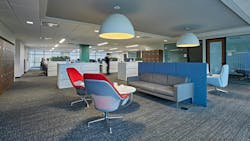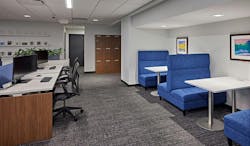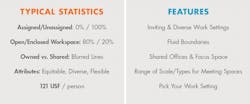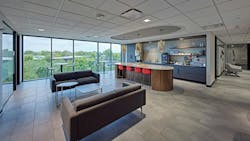Maximizing office square footage through ‘agile planning’
Agile planning is a popular workspace model that provides a flexible and adaptable layout design, while giving employees complete choice over their work setting. This planning model also easily accommodates changes in function or space usage over time.
In a previous post, we broke down the “Five Primary Models for Maximum Efficiency and Productivity.” As more and more businesses look to maximum their square footage, let’s take a deeper dive into one of the more popular models: Agile planning—also known as immersive planning.
Benefits of an Agile Plan
Agile planning is often applied in workspaces where the needs of occupants may evolve or where multifunctionality is desired. This model also lets occupants choose the work setting that is most appropriate for their workload that day.
- Supports both in-person and hybrid work models
- Allows employees to choose the work setting that best supports the tasks at hand
- Gives 100% ownership of where you work, how you work
- Reduces square footage by eliminating the number of dedicated workspaces
- Provides accessible and intuitive technology throughout the office
3 Zones of an Agile Office
Agile designs provide spaces for community, group, and individual work.
- Community spaces focus on social gathering and provide shared amenities. They can enrich the culture and provide spaces for employees to recharge throughout the workday
- Group zones encourage collaboration and knowledge sharing. These areas can be set up with diverse seating types in open or enclosed spaces and help bridge the gap between in-person and remote staff
- Individual areas allow employees to focus and keep their heads down in a respected quiet zone while they work. Unassigned workstations provide privacy as needed, where needed, while shared private offices and privacy pods offer flexible solutions to changing employee needs
Successful Implementation
A global insurance organization adopted a “work how you want, where you want” policy with a desire to reduce its footprint and create a space that supports a hybrid work model. By selecting an agile plan, the company was able to provide variety and choice of work settings while utilizing an unassigned neighborhood concept.
Furthermore, the company was able to decrease its square footage needs by more than half while increasing the employee capacity served through in-office and remote environments.
Making the Change
If you’re considering an office remodel or build and want to determine if an agile plan is the right fit for your company, consider what impactful spaces your workforce needs.
- Utilize surveys to collect staff feedback and understand the needs for all employees
- Conduct space utilization reviews to observe how the space is used. What is under-utilized? What gets the most use?
- Host a town hall to get all staff buy in, provide an open forum and engage the team.
Interested in learning more? Check out our featured workplace projects to see how other companies have chosen to maximize their workspaces and position themselves for success.



